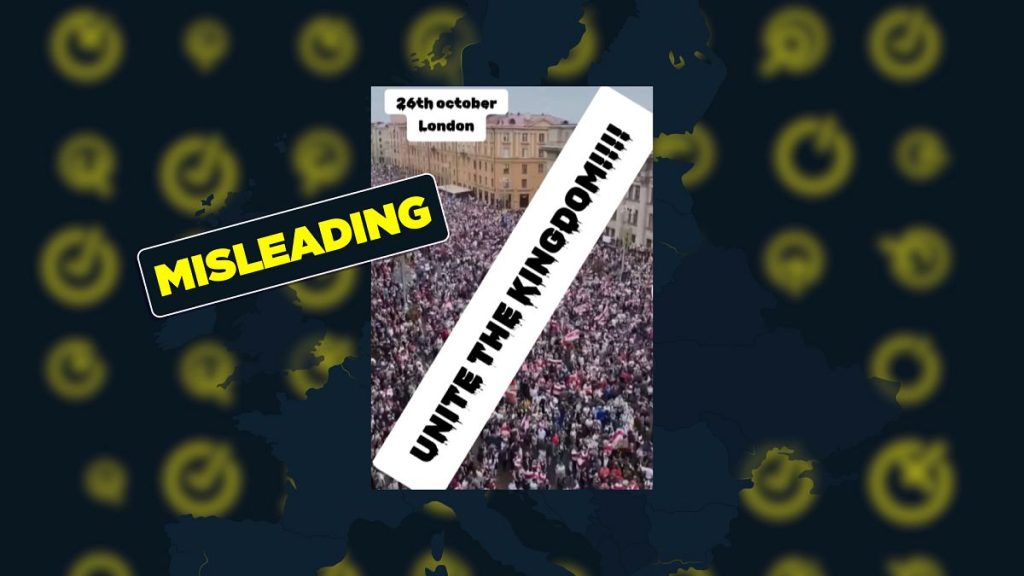The video of a supposed far-right demonstration in London in October 2024 that has gone viral on social media is actually footage from an anti-government protest in Belarus in August 2020. The 19-second video shows a large crowd on a main street waving red and white flags, with an overlapping text reading “Unite the kingdom”. The misinformation claims that 300,000 British nationalists gathered in London on the 26th of October and mentions far-right activist Tommy Robinson. However, a closer look reveals that the video actually shows protests in the Belarusian capital of Minsk on Independence Street, with the Government House visible in the background.
Protests erupted in Belarus after President Alexander Lukashenko claimed a landslide victory in the 2020 presidential election with 80% of the vote. His main challenger, Sviatlana Tsikhanouskaya, and her supporters disputed the results, alleging that the election was rigged. More than 100,000 people took to the streets of Minsk to protest against Lukashenko, who was beginning his sixth term in office. The demonstrators demanded the resignation of Lukashenko and the release of political prisoners. Despite attempts by police to disperse the crowds with water cannons, the protesters remained steadfast in their demands. Lukashenko dismissed the protests as being influenced by foreign powers, denying any wrongdoing.
The misleading video of the Belarusian protests being shared as a far-right demonstration in London highlights the dangers of misinformation and fake news spreading rapidly on social media platforms. The ability of individuals to manipulate content and present false narratives can have serious consequences, as seen in this case where a video from a legitimate protest in Minsk is being misrepresented to fit a completely different context. It is important for users to exercise caution and verify information before sharing it, to prevent the spread of misinformation and false beliefs.
The use of reverse image search can help in identifying the true source of videos and images shared online, as demonstrated in the case of the misleading video claiming to show a far-right demonstration in London. By analyzing the surroundings and landmarks visible in the footage, it becomes clear that the video is actually from the protests in Minsk, Belarus. This serves as a reminder of the importance of taking the time to fact-check and verify information before sharing it, to avoid perpetuating false narratives and contributing to the spread of misinformation.
The widespread circulation of the misleading video of the Belarusian protests as a far-right demonstration in London underscores the susceptibility of social media users to be influenced by false information. The manipulation of content to fit a particular agenda or narrative can easily deceive individuals who are not aware of the context or origins of the material being shared. It is crucial for users to be vigilant and critically evaluate the content they encounter online, so as to prevent the dissemination of inaccurate information and misleading interpretations. By promoting media literacy and encouraging users to fact-check information before sharing it, the spread of misinformation can be minimized and greater transparency achieved in the digital landscape.
In conclusion, the viral spread of the misleading video purporting to show a far-right demonstration in London when it is actually footage from protests in Belarus highlights the dangers of misinformation and the importance of verifying information before sharing it. The protests in Minsk were a response to disputed election results and calls for political reform, while the misrepresentation of the footage as a far-right demonstration in London serves as a cautionary tale about the potential for false narratives to influence public perception. By exercising critical thinking and fact-checking methods, social media users can help combat the spread of misinformation and promote a more accurate understanding of events and issues.















